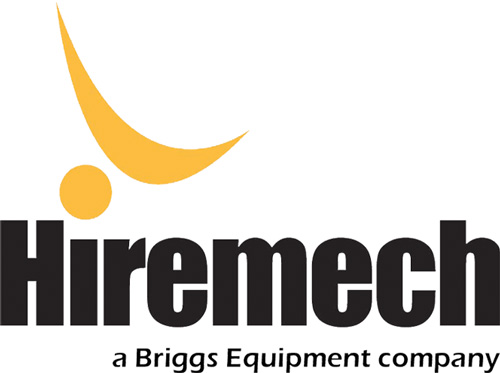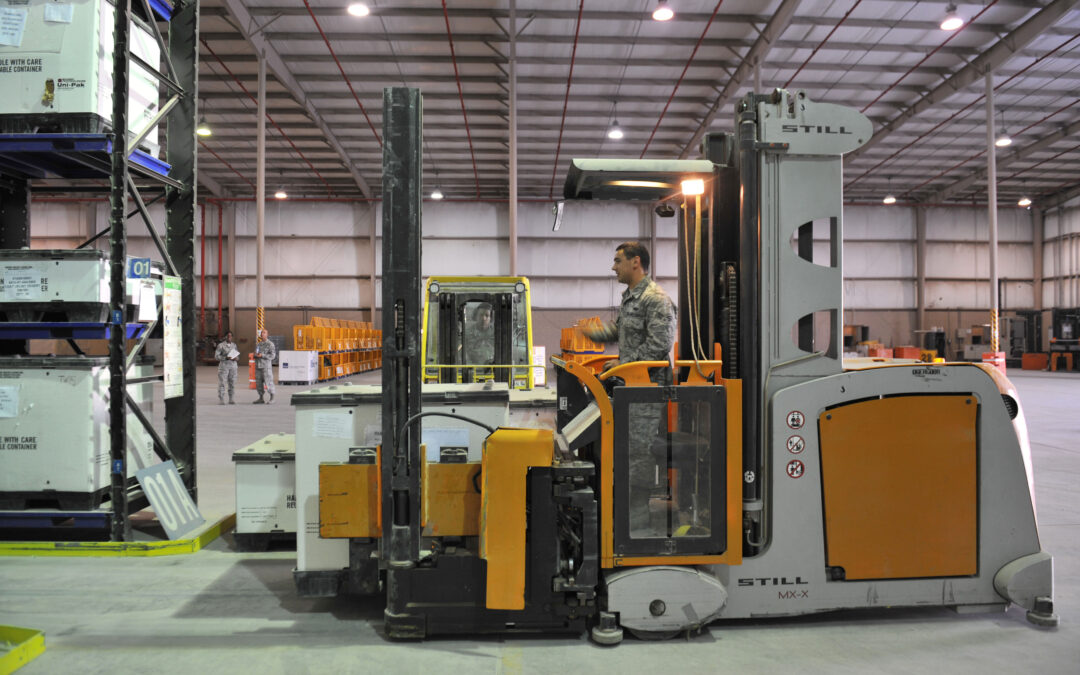Forklifts are powerful vehicles designed to move heavy loads around warehouses and construction sites. The wide variety of models can make it difficult to choose which forklift to rent or buy, so we have put together this useful guide to take you through the most popular forklifts available. By providing you with an overview of the machines available, we will help you decide which forklift suits your requirements.
1) Warehouse Forklift
The warehouse forklift is one of the most common types of lifting machinery. The compact design features extending twin forks to the front, making it a popular choice for warehouses with a large inventory. The forklifts are designed to easily move balanced materials and pallets, as well as unloading and loading items into delivery vehicles.
2) Side Loader
A side loader is a subtype of the warehouse forklift category. They are most commonly found in manufacturing environments with large and heavy items.
There are two main variations available, an enclosed cab for outdoor use and the more common stand-up version for indoor use. The sideways operation is designed so the operator stands in a compartment which allows the loader to unload or load objects on its side. There is also a multi-way version available with each wheel designed to rotate by 90°, this allows easy transportation of a load in any direction.
This design enables the forklift to drive alongside racking to load or unload, without having to turn in the tight space. Side loaders are suitable for units with narrow aisles such as those holding timber, steel or pipes. Their ability to carry long and heavy loads within narrow aisles makes them a popular choice for a number of industries.
3) Counterbalance Forklift
Industrial counterbalance forklifts are the most common option for indoor warehouses, although their versatile design also allows them to work outdoors on stable surfaces. The counterbalance forklift features dual forks to the front and a weight to the rear, which is designed to counterbalance the load weight. Unlike some machines, the counterbalance forklifts do not have extending arms, this gives the forklift the ability to position itself directly against the load.
There are a few different counterbalance designs, such as the 3-wheel variant which allows the machine to turn in a circle and the stand-up machines which make it easier for operators to climb in and out between loads. Although diesel and gas machines are available, the 3-wheel designs are almost all electric. These electric machines incorporate an economical motor, which increases productivity while offering relatively low costs of operation.
4) Telehandler
The telehandler is also known as a reach forklift or telescopic forklift. It is designed with a boom and extendable arm, which allows the machine to function as both a crane and a forklift. Their single telescopic boom means these machines are much more powerful and versatile than standard forklifts.
They are popular in many situations because of the wide range of available attachments, such as lift tables, buckets, muck grabbers and pallet forks. This versatility ensures the telehandler is able to reach into very tight spaces at awkward angles, where a normal forklift would not reach.
They are ideal for use within agriculture, or any industry which requires large loads to be moved. Their flexibility means they have started to replace rough terrain forklifts on many construction sites.
5) Industrial Forklift
The industrial forklift is a large capacity machine which provides a traditional warehouse style forklift with some of the abilities of a telehandler. Although it is unable to reach all the angles provided by a telehandler, it can lift heavier loads much higher than standard warehouse forklifts. They are also designed to be much narrower than telehandlers and warehouse forklifts.
6) Rough Terrain Forklift
A rough terrain forklift is designed for specific outdoor use on rugged and uneven surfaces. The trucks feature a counterbalance to the rear which prevents overbalancing while ensuring the machine can be easily driven in mud, snow or ice. They are common machines on construction sites, where their heavy lift capacities are particularly useful. They have a high load capacity of 16,000kg, although the Kalmer forklift can lift an impressive 90,000kg.
The trucks feature strong pneumatic tyres which enable them to navigate difficult terrains. The oversized inflatable tyres with thicker threads provide improved balance and stability, allowing materials to be safely transported across difficult sites. They also have a powerful engine so the machine can reach higher speeds with improved manoeuvrability.
7) Pallet Jacks
Pallet jacks are also known as pump trucks, and their small design is not capable of lifting large loads. Instead, the specialised design has a very small footprint which ensures it fits into tight spaces. Although there is a sacrifice in power, the low cost of the pallet jacks makes them an ideal option for smaller spaces. There is a wide range of pallet jacks available, including low profile machines, all-terrain jacks, long and short forked and those with narrow or wide fork spreads.
They are commonly used in storage facilities and warehouses to enable operators to move pallets quickly and easily. They feature a set of forks which slide beneath a pallet, and the operator then pumps the handle to lift these forks from the ground. There are front wheels positioned below the forks which are then vertically separated as the pallet is raised. Although, if you are looking for a more efficient option, there are powered options available, which improve the speed and handling of taller stacks of pallets.
8) Stackers
Stackers are specifically designed for small spaces and work in a similar way to pallet jacks, although they are able to reach much higher. There are many types available which are all designed for specific uses including wrap over stackers, powered stackers and electric straddle stackers.
They are usually electrically powered and are designed to allow the worker to walk behind the machine. The machine is then steered into position using a convenient handle. The compact chassis and controlled handling make them ideal for many applications, including order picking, vehicle loading, block stacking and transporting pallets.
9) Order Picker
An order picker is similar to a stacker, as it is also used to pick and deliver items within storage areas. A standard order picker is designed to reach heights of 32ft, which is ideal for lifting people to the top of warehouse racks. As modern businesses aim to lower their distribution costs, these are increasing in popularity thanks to their ability to efficiently pick items at great heights.
The design makes them ideal for warehouses and storage facilities which hold customers’ orders. They are electrically powered and lift the operator on an elevated driver platform. This allows one or two items to be lifted rather than a full load or pallet.
10) Reach Fork Truck
This forklift is mainly used indoors within warehouses, as their low clearance levels mean they would struggle outdoors. The reach fork trucks feature extendable forks which can reach into the racking, unlike standard forklifts which do not extend beyond the compartment.
Their extended reach height and space-saving design is ideal for any warehouses which use high rise pallet racking within narrow aisles. The trunk of the machine will shorten itself by pulling the load in towards the vehicle, to improve stability and manoeuvrability to allow these machines to safely lift up to 2,500kg.
11) Electric and Utility Vehicles
There are many types of electric and utility vehicles available, which make it possible to complete a variety of tasks. Whether you need to move items to a new facility or just across a warehouse, their versatility and low running costs are making them a popular choice for many sites. There are a variety of options available which are ideal for both industrial and agricultural applications.
Indoor or Outdoor Forklifts
If you plan on using the machine indoors, an electric forklift will be the best option. These are powered by batteries and are designed to provide enough power to cover a standard-length shift. Their environmentally friendly design is cheaper to run, and they are very quiet when compared to other forklifts.
Outdoor forklifts tend to be either gas or diesel powered. The gas forklifts are designed to run using gas canisters, which makes them quick and simple to refuel. Although they are cheaper to purchase than an electric forklift, gas is an expensive fuel and will require appropriate storage. A gas forklift can be used for short periods indoors if the area is well-ventilated.
Alternatively, diesel forklifts provide another low-cost option which is also quick and simple to refuel. These machines cannot be used indoors due to their emissions, instead, they are designed for tough outdoor terrain. They are commonly used in environments where large heavy loads need transporting, although they can also be used for towing and pushing.
There are several types of forklifts available, which vary in terms of their lift capacity, dimensions, fuel type, tyres and reach. To help you decide which forklift is best for your site, you will need to consider factors such as the capacity required, the access to the site and the terrain. By considering every aspect, you will be able to decide which forklift will perform efficiently and safely.
We are proud to have more than twenty years’ experience providing forklifts and are committed to offering our customers a personalised service. Our team will discuss your specific requirements and budget so that we can supply the right forklift for your task. To find out more about the wide range of forklifts which we have for sale or rent, please contact our experienced team.

 020 8880 3322
020 8880 3322